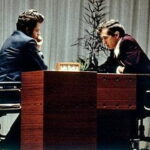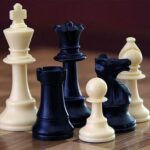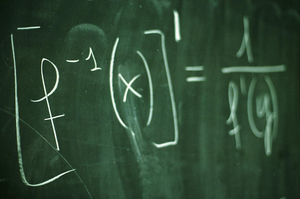The theme of Samuel Beckett’s Endgame is the angst and universal inevitability of endings, particularly the ultimate ending — death. Endgame’s primary assumption is that there are endings to everything. As the play opens, three of the four characters are in the final stages of life by virtue of age or infirmary. The stage is barren with the exception of the protagonist Hamm’s chair and the two ashbins in which his parents, Nagg and Nell, reside. Throughout the play the characters refer to earlier times in which they travelled, had material possessions, and knew people besides the each other – that world is gone. The world beyond the room’s unfolding drama appears to have all but ended – Clov, the only character who is independently mobile, looks through a telescope and remarks that the world is “Corpsed.”
Beckett uses the chess endgame as a metaphor to tell the story of lives formerly populated with other people and activity. Even a casual chess player or observer chess board can relate to the futility of a board whittled down to only four chessmen, two of which are static.
The play begins with an opening tableau of Hamm’s chair center stage, a metaphorical king; Clov, his servant and possibly son, a mobile supporting piece such as a bishop, lacking the robust natures of a knight or a rook; and the two ashbins, the static relics of a defensive row of pawns. As in a losing endgame of chess, Beckett uses repetition – often implied, as in the retelling of Hamm’s story and the pointless tours of the walls -attempting to stave off the inevitable final ending. Death is a universal certainty and Nell’s death is surely only the first of the play’s characters to die in the near future. Beckett’s excellent use of the chess endgame metaphor predicts that a finite series of recurring events results in an inevitable outcome.
Clov remarks, “Something is taking its course.” An endgame with a king, bishop, and two pawns would allow for only a finite series of moves dodging an attacker – in this case death – with minimal chance of a victory. As the play ends, Hamm discards the final trappings of his life illusions – his three legged dog doll, his stick, and his whistle – he is essentially resigning from the game. Hamm sits back, presumably dying, along with the unmoved ashbins containing his parents, and Clov — standing silently beside Hamm and dressed to leave – they repeat the play’s opening tableau demonstrating that the day’s events were meaningless to the inevitable final outcome.




